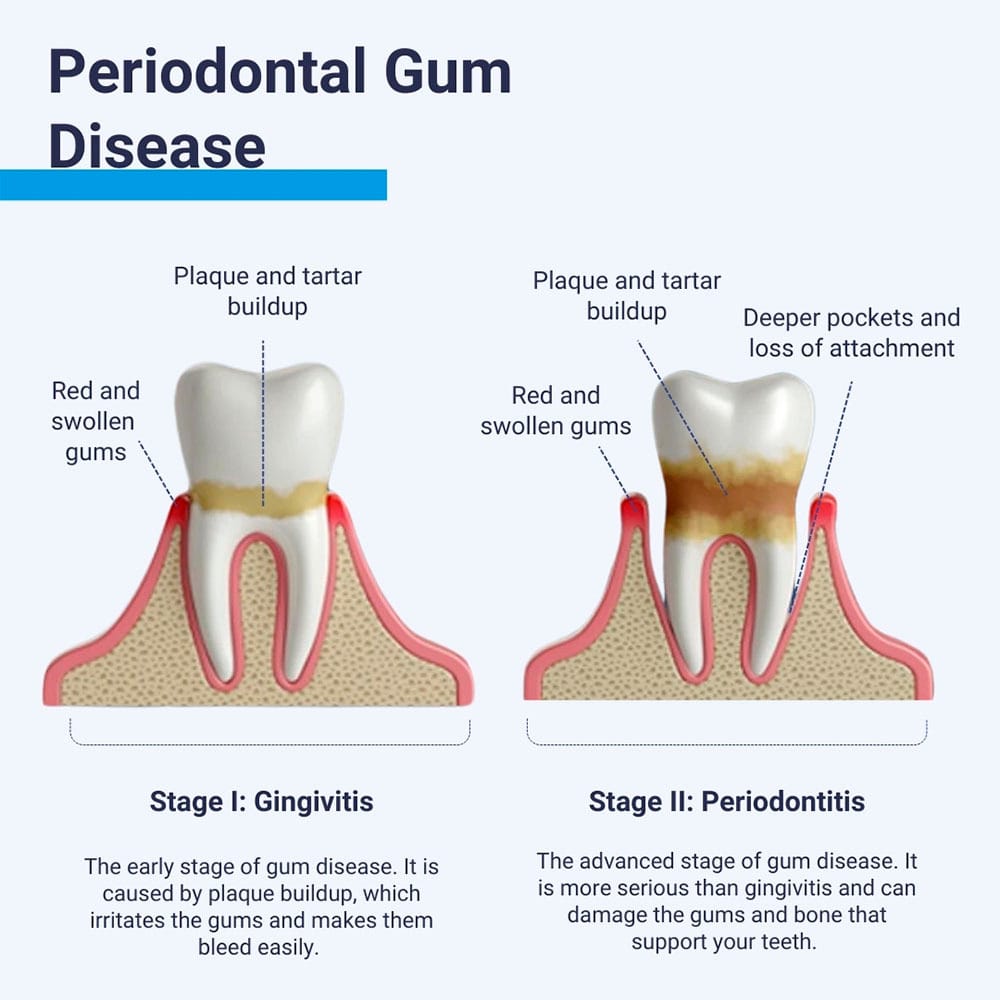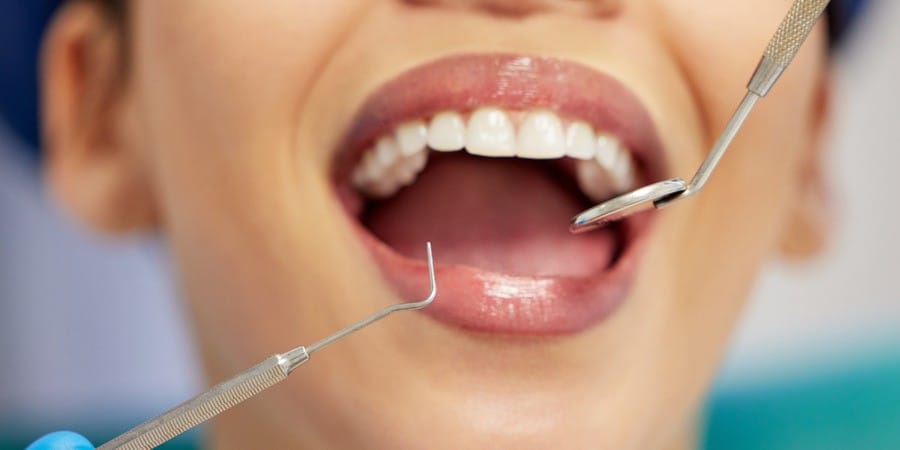What Is Gum Disease?
Gum disease or periodontal disease develops when the bacteria in dental plaque build-up. These bacteria infect and inflame your gums, causing gum disease.
There are two stages of gum disease: gingivitis and periodontitis.
Gingivitis
Gingivitis is mild gum disease, and we can easily treat this condition by cleaning your teeth and gums professionally and working with you to improve your oral care routine at home.
Periodontitis
Periodontitis is a different matter, and at this point, your gums will have begun pulling away from your teeth, creating gaps or pockets between your teeth and gums. These are called periodontal pockets and create the ideal conditions for plaque bacteria to multiply and thrive.
Periodontal pockets can be quite deep, so you will struggle to clean them with an ordinary toothbrush and dental floss. Without treatment, these pockets can deepen and worsen, and the bone around your teeth will gradually be destroyed.
Advanced gum disease can cause tooth loss. Periodontitis can negatively impact overall health and is linked to serious problems like diabetes, respiratory illnesses, and cardiovascular disease.

Who Would Need Osseous Surgery?
Gum health is extremely important; we assess your gums’ condition during every dental exam. We take detailed measurements around every tooth to assess the depth of the space between each tooth and gum. If the depth of the spaces exceeds 3 mm, you may have some form of gum disease. In such cases, we may recommend LANAP laser gum therapy, a minimally invasive treatment option that effectively targets and removes infected tissue while promoting healthy gum regeneration. This advanced procedure helps treat gum disease with less discomfort and a faster recovery time compared to traditional treatments. If you are concerned about your gum health, contact us to learn more about LANAP and how it can benefit you.
If we suspect you have gum disease, we will suggest you see our periodontist, Dr. Richard Nejat, for more specialized treatments that may include osseous surgery.
Dr. Nejat can complete a full periodontal evaluation and determine the degree of infection in your gums. He will then recommend a suitable treatment plan.
What Is Osseous/Gum Surgery?
Osseous surgery is an advanced procedure that removes bacteria deep inside periodontal pockets. Treatment aims to reduce the depth of periodontal pockets, eliminate or control bacteria, and make it easier for your gums to fight infection and return to health.
The process reshapes and smooths damaged tooth roots and jawbone. If necessary, bone can be regenerated using dental bone grafts. There are two types of osseous gum surgery: traditional and laser osseous surgery.
Traditional Osseous Surgery
During traditional osseous flap surgery, small incisions are made into your gums to expose your tooth roots. The bone around your teeth is reshaped. This helps remove the periodontal pockets and bacteria. Once the process is complete, your gums are stitched up and left to heal.
Laser Osseous Surgery
At Clock Tower Dental, we can provide laser osseous surgery. Our dental office is equipped with a Millennium PerioLase MVP-7 Dental Laser. This advanced laser can treat soft tissues like gums and help regenerate bone. It is the perfect tool for treating tissues destroyed by advanced periodontitis.
Advantages of Laser Osseous Surgery
During laser osseous surgery, laser energy sterilizes the areas treated, killing harmful bacteria and helping preserve healthy tissue. There is less need for any incisions or stitches. If we use the laser to make any cuts, the energy automatically seals the wound through thermal coagulation.
It is a gentle treatment with fewer side effects afterward. There is less swelling and minimal bleeding, helping to aid faster and more comfortable healing.
When periodontitis is especially severe, we may use both treatments to help produce better results. Other treatments like teeth scaling and root planing may also be necessary. Advanced periodontitis can be chronic, so you might need to follow an ongoing treatment plan provided by our dental office.
Additionally, if you require wisdom teeth removal, our dental team can assess your oral health to determine if extraction is necessary to prevent or address complications, such as overcrowding, infections, or gum issues.
What to Expect During Osseous Surgery
The process is very straightforward. Dr. Nejat will want to review your dental and medical health carefully.
Certain medications may affect the treatment we prescribe, particularly anticoagulants. You may need to stop taking any blood thinners before surgery and discuss this with your healthcare provider.
During your consultation, we will discuss what to expect during and after surgery and can provide detailed information on preparation and after-care. Below is a brief outline of what you can expect to happen, but your treatment is tailored to meet your needs, so it may be slightly different.
Preparing for Osseous Surgery
- We will provide local anesthetic or can discuss sedation dentistry to ensure you feel relaxed and comfortable in the dental chair.
- A small incision is made into your gum so we can fold back the gum and expose your tooth roots.
- All dental plaque is removed from your tooth root surfaces.
- If osseous bone surgery is needed, we carefully reshape the bone around your teeth to remove damaged areas and reduce the size of periodontal pockets.
- If your jawbone has been significantly damaged, we may use advanced procedures to help regenerate, including bone grafting.
- Your gums are repositioned over your tooth roots and closed shut.
Recovery after Osseous Surgery
The recovery time needed after osseous surgery depends on the number of teeth we must treat and the severity of your periodontitis. You can expect to spend anywhere between two and four weeks healing after oral surgery.
Common side effects immediately afterward include:
- Bleeding
- Soreness
- Bruising and swelling
All these side effects are normal and should disappear within a few days.
Before you leave our dental office, we will give you comprehensive instructions on caring for your mouth while healing. Closely following them will help you heal more quickly and smoothly.
Points to consider include:
- If we have prescribed medication, please take it as directed, especially antibiotics.
- Initially, eat softer foods that require minimal or no chewing, such as scrambled eggs, mashed potatoes, and Mac and cheese. We can provide a list of suitable foods so you can stock up before surgery.
- Follow our instructions on keeping your mouth clean during healing, such as using a salt water rinse or antimicrobial mouthwash.
- Avoid using a drinking straw for at least one week after surgery.
We will schedule follow-up appointments with you. Please ensure you attend them so we can check that your gums are healing well and that the size of your periodontal pockets is reducing. Additionally, if you have concerns about an impacted tooth, we can evaluate your condition and recommend appropriate treatment options to prevent further complications and maintain your oral health.
Are there Any Risks and Complications of Osseous Surgery?
Most people heal well without any complications, but there is always a small risk of infection or other issues like bleeding. If you are concerned about your oral health during osseous surgery recovery, please don’t hesitate to contact us.
What Are the Benefits of Osseous Surgery?
Benefits of osseous surgery include:
- Healthier, stronger gums that fit more snugly around your teeth.
- Plaque bacteria are less able to reattach to tooth roots.
- Oral hygiene is easier to maintain.
- Treatment can help protect overall health.
Maintaining the Results
After your osseous gum surgery, we can discuss maintaining the results. We can recommend a suitable ongoing preventive dental care plan, including teeth scaling and root planing treatments. Our hygiene team can work with you to ensure you follow the best oral care routine at home.
Are There Any Osseous Surgery Alternatives?
One possible alternative treatment would be a laser-assisted new attachment procedure (LANAP). Our periodontist can provide this advanced procedure, but it may not be right for everyone. If possible, Dr. Nejat will discuss this procedure with you in detail. You can find out more information about LANAP on our website.

